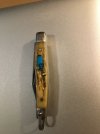-
The BladeForums.com 2024 Traditional Knife is ready to order! See this thread for details: https://www.bladeforums.com/threads/bladeforums-2024-traditional-knife.2003187/
Price is $300 ea (shipped within CONUS). If you live outside the US, I will contact you after your order for extra shipping charges.
Order here: https://www.bladeforums.com/help/2024-traditional/ - Order as many as you like, we have plenty.
You are using an out of date browser. It may not display this or other websites correctly.
You should upgrade or use an alternative browser.
You should upgrade or use an alternative browser.
Case Knife badge popped out
- Thread starter P_D
- Start date
I don't suggest using Gorilla glue for anything that you want to look nice. The glue bubbles up and expands into a cream colored foam as it dries. The foam surrounds whatever you glued. It holds well but it's not pretty. That was my experience when I used it years ago, and I stopped using it because of that.
Bill DeShivs
Knifemaker / Craftsman / Service Provider
- Joined
- Jun 6, 2000
- Messages
- 12,495
Adam said "Gorilla Glue Super Glue," not Gorilla Glue.
cudgee
Gold Member
- Joined
- May 13, 2019
- Messages
- 7,572
I presumed that he would have realized that from the first post. My mistake.Adam said "Gorilla Glue Super Glue," not Gorilla Glue.
- Joined
- Apr 12, 2009
- Messages
- 13,349
I have a Case 5344 stockman (pictured below) that had the same issue, with the shield dropping out three times over a span of several years. The first two times, I used CA glue (cyanoacrylate, a.k.a., 'superglue') in gel form to glue the shield back in. I even advocated for CA glue here on the forum, for such issues, as it initially seemed like a perfect and easy solution. But for some reason, the hold never lasted and it seemed as if the stag covers on that knife just absorbed the glue, leaving little or no obvious visible trace of it in the milled recess of the stag. When it came out again, just a year or two ago, I decided to epoxy it back in place. I've never had any problems with epoxy letting go, and haven't had another 'fallout' of the shield from that knife since I fixed it. After fixing that, I've tested it to see if the shield might be prone to coming out, tapping it against a tabletop. I haven't been able to force it out since, so I think the epoxy was the right solution for that one. Might be one of those 'YMMV' things, as I assume some fixes with CA glue may not have the same issue with particular knives and will work out fine.


Last edited:
cudgee
Gold Member
- Joined
- May 13, 2019
- Messages
- 7,572
Off topic, but beautiful knife.I have a Case 5344 stockman (pictured below
My initial reaction to the thread was "I'd use epoxy" ... but since it's never happened to me, I've never tried either adhesive for this particular job.... When it came out again, just a year or two ago, I decided to epoxy it back in place. I've never had any problems with epoxy letting go, and haven't had another 'fallout' of the shield from that knife since ...
Personally, I'd degrease the knife scale and badge real well with brake cleaner, then epoxy it in place. I use epoxies a lot, and since I have a variety of them, I'd use West System G-flex (which seems to grip better than anything I've ever used) but if I didn't have that, I'd use any low-viscosity epoxy I could find, such as the stuff they sell at Walmart in twin tubes...in my experience, degreasing and scuffing up the bonding surfaces (to give the glue some "tooth"), then degreasing again, may be more important than anything else in any adhesive bond.
Synthetic products (all kinds of plastic, kevlar, micarta, teflon and similar) react different on CA glue. Some of those synthetic materials can not be glued with ''basic'' CA glue we usually get in grocery stores.
For example; you can't glue teflon plastic with CA glue.
If we need to glue plastic or some other synthetic material in industry first we must know what sort of plastic we want to glue and then we buy a specific glue for this plastic.
In your case I would use epoxy.
For example; you can't glue teflon plastic with CA glue.
If we need to glue plastic or some other synthetic material in industry first we must know what sort of plastic we want to glue and then we buy a specific glue for this plastic.
In your case I would use epoxy.
Last edited:
One of the problems gluing many plastics such as polyethylene and polypropylene is that they are technically waxes in their molecular structure. (I don't know of any knife scales made of these materials, though.)
One way to make polyethylene and similar plastics glue-able or paintable is to "flame treat" them, which converts the molecules at the surface of the plastic from non-polar to polar:
The West System epoxy folks did some R&D on this and found that the best solution was to degrease the plastic with alcohol, then flame treat it, then glue it.
One way to make polyethylene and similar plastics glue-able or paintable is to "flame treat" them, which converts the molecules at the surface of the plastic from non-polar to polar:
The West System epoxy folks did some R&D on this and found that the best solution was to degrease the plastic with alcohol, then flame treat it, then glue it.
CVamberbonehead
Gold Member
- Joined
- Nov 6, 2017
- Messages
- 2,165
Id use 2 part epoxy. Ive done it before and it works well.

